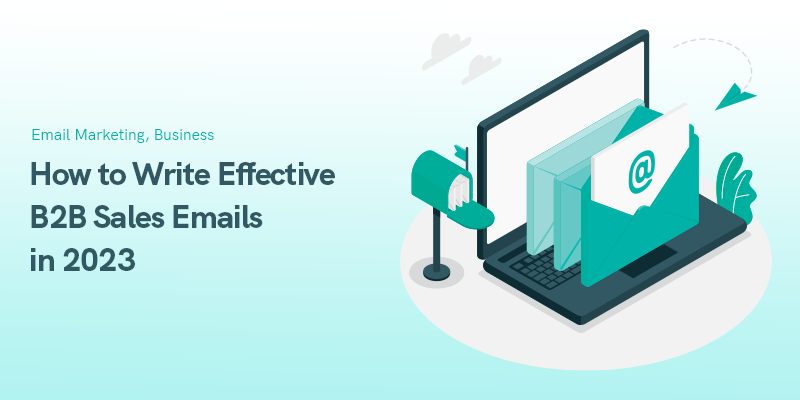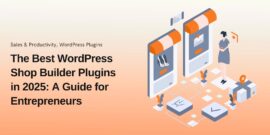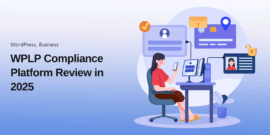
How to Write Effective B2B Sales Emails
Most B2B marketers always face an uphill task when it comes to their email marketing campaigns.
They often confuse B2B and B2C email campaigns and use the same email techniques, and that's where they lag the whole process.
Both B2B and B2C businesses have different audiences and prospects.
Hence, the approaches for both cannot be the same.
On that note, here we are with this blog that will help you through your B2B email campaign.
By the end, you'll have a clear idea about B2B Email campaigns and the best tips to do this effectively.
Why Is Email Marketing Important?
The business-to-business email marketing is a great way to promote your business.
The marketers use this medium to inform their customers about their brand, new product launch, price changes, product updates, new features, upcoming events, etc.
The key reason why marketers prefer using email marketing is that this lets you push your leads in the sales funnel quite effectively to the next stage.
You must be thinking, what is a sales funnel?
What Is A Sales Funnel?
This is what the stages of a sales funnel look like:
Awareness
Awareness is the first stage of the sales funnel where you make people aware of you, your company, and your products through advertisements and promotions.
To make your customers aware of your product or service, you need to use different ways, like social media outreach, cold email marketing, and so on.
Interest
When someone is in the “interest” stage of the sales funnel, they are actively browsing or researching about your product but not ready to buy.
This means you need to make it easy for them to find clear information about your product, and there are a few ways you can do that.
The best way to push someone to the next stage of the funnel is to have great content that the user wants to read.
You need to have clear information about your product in your emails or whatever communication platform you are using so that when someone wants to know about your product, they can get to know about it easily.
Consideration
The consideration stage of the sales funnel is the first step toward a conversion.
Leads here think about buying a product, but they aren’t ready to buy it right away.
This stage is where potential customers gather information and decide whether or not they should invest in your product or service.
Evaluation
The Evaluation Stage is where the prospects decide if to buy your product or service but they are checking on offers or other factors.
If you want to build a strong brand and take advantage of the buying power of your customers.
The evaluation stage is a delicate balance, and if you aren’t careful, you could damage your brand by pushing too hard or not enough.
It comes down to offering a product or service that is needed and wanted by your customers.
Purchase
The final purchase stage is the last in the customer sales funnel.
It is said that the sale is not complete until the customer makes a final purchase.
In fact, nine out of every ten customers will purchase if they reach the final stage of the funnel.
This is why it is important to ensure that your final purchase stage is designed around the customer’s needs.
How to Write Effective B2B Sales Emails in 2023
Email marketing is critical to the success of any business.
With emails, you can build and nurture relationships with potential clients and customers.
Does this mean you’ll yield those positive results after writing your B2B emails? Not necessarily. You still need to write an excellent B2B email in the first place.
The Difference Between B2C & B2B
Before crafting an email, it always becomes essential to understand the difference between B2C and B2B marketing.
Clients from both sides have different requirements and choices.
B2B clients always focus on what they need and never make purchases on whims.
Thus, B2C marketers can write to customers as a person and create one-on-one relationships. When sending emails to a B2B audience, creating a one-on-one relationship with customers is more complicated.
With B2B, you are writing to a person, but you are doing it as a brand.
Hence, it’s important to craft your emails, focusing on the product and the value you can provide while addressing a B2B client.
Now let’s see what instructions to follow in order to write a perfect B2B email.
Use an Eye-Catching Subject Line
Getting your subject line right is the first step toward composing a compelling email.
An eye-catching email subject will entice your recipient to open your email.
Keep your subject line short.
Your recipient should be able to read the entire email subject line with one look at their inbox.
Make sure your email subject line is personalized, too.
Remember, your recipients are busy people. If your email subject line is generic, it will only be ignored.
While creating subject lines for B2B sales emails, avoid using words that pack too much of an emotional punch.
Prioritize Content Over Pitching
B2B clients are pitched to all the time.
You can understand, then, why they hate pitches.
If your email comes across right off the bat as a pitch, expect them not to read it.
Business prospects love learning about new things. That’s why the best B2B company blogs focus more on content than selling something.
If you provide your prospects with thought-provoking, actionable content, they'll be more likely to read your email.
The rise of generative AI tools also presents new opportunities.
An AI writing generator platform like Simplified and Ask Writer allows you to create sales prospecting emails with simple prompts.
These tools can give you a good starting point in crafting valuable content for your B2B sales emails.
Personalize Your Email Body
We talked about the importance of personalizing subject lines.
Well, just as important is personalizing the email body.
So, instead of starting the email with a “to whom it may concern,” use the recipient’s name from the get-go, if you can.
But email personalization isn’t just that. Email personalization is ensuring that your email content is tailored to your recipient.
So, if your prospect is a sales manager, for example, your content shouldn’t be about designing websites.
Add a Strong CTA
It’s not enough for you to share valuable content with prospects.
Remember, your goal is still to generate a sale.
That means your email should tell prospects exactly what to do.
That action should bring you closer to converting them into paying customers.
So, make sure your emails have a strong call to action.
Through your email CTA, you may ask prospects to click on a link so they can schedule a product demo, reply to your email if they have any queries.
Send Timely Follow-Ups
Let’s say you sent your email but didn’t get any response.
That doesn’t mean you should forget your prospect and move on to the next.
Remember, your prospects are busy people.
They probably only need to be reminded that you sent them an email.
For this reason, follow-up emails should be part of your B2B email marketing strategy.
Besides, when you follow up, you also show your prospect your dedication as a company.
Conclusion
To succeed as a B2B business, you must know how to build and nurture business relationships with potential clients.
That means you need to know how to write an effective B2B sales email.
Use a short and personalized subject line to hook your prospect.
In writing your email, make sure you prioritize content over pitching. Tailor your email content to your prospects, too.
Personalizing your email body requires researching the B2B prospects you're reaching out to.
Also, add a strong CTA in your emails.
Make sure you don’t include too many. One CTA per email is ideal. Finally, send timely follow-ups.
If you follow these tips, you can write effective B2B sales emails that generate conversions.
Your company will be well on its way to success. Best of luck!
Recommended Posts

How to Create an Effective Event Marketing Plan from Scratch in 2025
December 22, 2025


